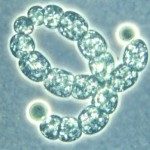Link to Pubmed [PMID] – 11526136
J. Clin. Microbiol. 2001 Sep;39(9):3104-9
The number of stable discriminant biochemical characters is limited in the genera Alcaligenes and Agrobacterium, whose species are consequently difficult to distinguish from one another by conventional tests. Moreover, genomic studies have recently drastically modified the nomenclature of these genera; for example, Alcaligenes xylosoxidans was transferred to the genus Achromobacter in 1998. Twenty-five strains of Achromobacter xylosoxidans, three strains of an Agrobacterium sp., five strains of an Alcaligenes sp., and four unnamed strains belonging to the Centers for Disease Control and Prevention group IVc-2 were examined. These strains were characterized by conventional tests, including biochemical tests. The assimilation of 99 carbohydrates, organic acids, and amino acids was studied by using Biotype-100 strips, and rRNA gene restriction patterns were obtained with the automated Riboprinter microbial characterization system after cleavage of total DNA with EcoRI or PstI restriction endonuclease. This polyphasic approach allowed the two subspecies of A. xylosoxidans to be clearly separated. Relationships between five strains and the Ralstonia paucula type strain were demonstrated. Likewise, three strains were found to be related to the Ochrobactrum anthropi type strain. We showed that substrate assimilation tests and automated ribotyping provide a simple, rapid, and reliable means of identifying A. xylosoxidans subspecies and that these two methods can be used as alternative methods to characterize unidentified strains rapidly when discriminant biochemical characters are missing.


